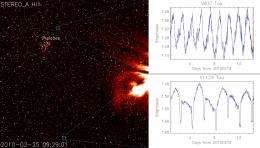Image caption: A STEREO/HI-1A image taken on 7th March 2010 (left) with two variable stars highlighted in the image. The varying brightness of the two stars, V837 Tau and V1129 Tau are shown (right top and bottom, respectively). Credit: Image produced by D. Bewsher (UCLan). Data courtesy of NASA/STEREO and the HI instrument team.
(PhysOrg.com) -- Researchers have discovered 122 new eclipsing binary stars and observed hundreds more variable stars in an innovative survey using NASA's two STEREO solar satellites. The survey has been carried out by team from the Open University, University of Central Lancashire and the STFC Rutherford Appleton Laboratory. Dr Danielle Bewsher presented highlights at the RAS National Astronomy Meeting in Llandudno, Wales on Tuesday 19th April.
STEREO was launched in 2006 to study the Sun in 3D and coronal mass ejections, the cause of space weather. Each STEREO spacecraft carries a Heliospheric Imager (HI), each instrument comprising two cameras (HI-1 and HI-2) built and developed at the STFC's Rutherford Appleton Laboratory and the University of Birmingham. The HI cameras are able to make such stable measurements that researchers can accurately monitor the brightness of stars in the background.
"Although STEREO is primarily a solar mission, we recognised that the stability of the HI cameras could also be used to monitor variations of the brightness of stars," said Bewsher, of the University of Central Lancashire. "To date, 893 000 stars have passed through the HI-1 field-of-view alone, producing an unexpected resource of scientific data about the variability of stars that is currently being data mined."
The lead author, Karl Wraight, an STFC PhD student at the OU, has found the 122 new eclipsing binaries during an initial analysis of the data, and expects many more to be discovered.
"STEREO's ability to sample continuously for up to 20 days, coupled with repeat viewings from the twin spacecraft during the year, makes it an invaluable resource for researching variable stars. As well as making discoveries, observations from HI are enabling us to pin down the periods of known variables with much greater accuracy," said Wraight.
In addition to studying variable stars, the team believes that HI measurements may be used for exoplanet and astroseismology research.
"Very small changes to the brightnesses of stars can be detected, which could reveal the presence of transiting exoplanets, or be used to trace a star’s internal structure by measuring their seismic activity," said Professor Glenn White (RAL and OU).
Provided by Royal Astronomical Society























